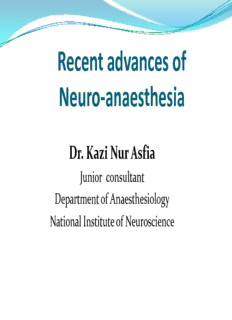
Recent advances of Neuro-anaesthesia PDF
Preview Recent advances of Neuro-anaesthesia
Recent advances of Neuro-anaesthesia Dr. Kazi Nur Asfia Junior consultant Department of Anaesthesiology National Institute of Neuroscience Highlights I. History of Neuroanaesthesia. II. Neurophysiology review. III. Effects of Anaesthetic agents on brain. IV. Clinical aspects of Neuroanaesthesia. V. Emergence & Post operative care. VI. Prognosis factors . I.History of Neuroanaesthesia Surgical necessity has yielded the development of anesthesia and advances in anesthesia have provided further development in surgery. This is also true for neuro anesthesia and neurosurgery. The earliest neurological surgery record is in the Edwin Smith Papyrus Trephination (burr holes), done in BC 3000-2500. In the middle age anaesthesia was provided with “Narcosis“, by cannabis indica, henbane, opium, wine, and mandrake. History On october 16, 1846: First Neuroanesthesia was under the influence of ether anesthesia in the “Ether Dome” amphitheater at the Massachusetts General Hospital by William T. G. Morton for Removal of a head and neck tumor by Dr. John C. Warren from a patient, Edward G. Abbott. In the late 19th and early 20th centuries, Neuroanaesthesia develop as a subspecialty due to interest of surgeons : William Macewen & Victor Horsley in Great Britain. Fedor Krause in Germany. Harvey Cushing in USA. History ( 1949) Albert Faulconer (father of neuroanesthesiology). with neurologist, Reginald Bickford, began work on the electroencephalogram (EEG) responses to anesthetics. (1961) John D. “Jack” Michenfelder, MD( father of modern neuroanesthesiology) discover profound hypothermia to facilitate the clipping of cerebral aneurysms. Albert Faulconer, MD, . John D. “Jack” Michenfelder, MD II. Neurophysiology review Six interrelated components of neurophysiology that are important to the practice of neuroanesthesia: 1.Cerebral perfusion pressure (CPP). 2.Cerebral blood flow (CBF). 3.Cerebral blood volume (CBV). 4. Intracranial pressure (ICP). 5. CO2 responsiveness (CO2R). 6. Cerebral metabolic rate of Oxygen (CMRO2). 1.Cerebral perfusion pressure (CPP). CPP is the net pressure gradient causing cerebral blood flow to the brain (brain perfusion). CPP= MAP – ICP. Normally CPP is 80-I00 mm Hg. When CVP is significantly greater than ICP, CPP= MAP-CVP CPP determines brain blood perfusion when ICP is elevated, otherwise ABP is main determinant. Too low CPP- ischaemia, too high- hyperaemia 2.Cerebral blood flow (CBF). CBF Cerebral blood flow (CBF) is the blood supply to the brain in a given period of time to meet brain's metabolic demands. CBF= CPP / CVR 15-20% of cardiac output. Total average CBF is 750ml/min . Gray matter has a higher flow than white matter. CBF is autoregulated – remains constant over a wide range of MAPs (50 – 150 mmHg).
Description: